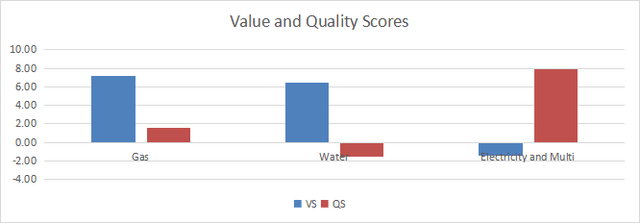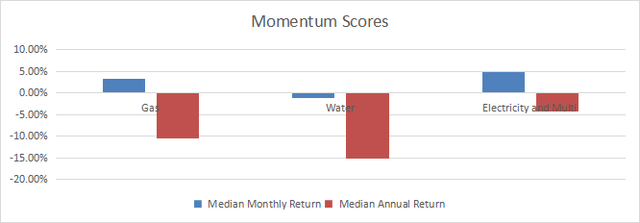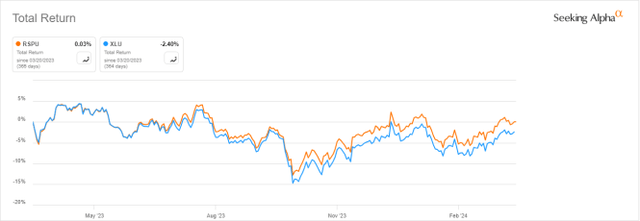This monthly article series shows a dashboard with aggregate industry metrics in utilities. It is also a top-down analysis of sector ETFs like the Utilities Select Sector SPDR® Fund ETF (XLU) and the Invesco S&P 500® Equal Weight Utilities ETF (NYSEARCA:RSPU), whose holdings are used to calculate these metrics.
Shortcut
The next two paragraphs in italic describe the dashboard methodology. They are necessary for new readers to understand the metrics. If you are used to this series or if you are short of time, you can skip them and go to the charts.
Base Metrics
I calculate the median value of five fundamental ratios for each industry: Earnings Yield (“EY”), Sales Yield (“SY”), Free Cash Flow Yield (“FY”), Return on Equity (“ROE”), Gross Margin (“GM”). The reference universe includes large companies in the U.S. stock market. The five base metrics are calculated on trailing 12 months. For all of them, higher is better. EY, SY and FY are medians of the inverse of Price/Earnings, Price/Sales and Price/Free Cash Flow. They are better for statistical studies than price-to-something ratios, which are unusable or non available when the “something” is close to zero or negative (for example, companies with negative earnings). I also look at two momentum metrics for each group: the median monthly return (RetM) and the median annual return (RetY).
I prefer medians to averages because a median splits a set in a good half and a bad half. A capital-weighted average is skewed by extreme values and the largest companies. My metrics are designed for stock-picking rather than index investing.
Value and Quality Scores
I calculate historical baselines for all metrics. They are noted respectively EYh, SYh, FYh, ROEh, GMh, and they are calculated as the averages on a look-back period of 11 years. For example, the value of EYh for hardware in the table below is the 11-year average of the median Earnings Yield in hardware companies.
The Value Score (“VS”) is defined as the average difference in % between two valuation ratios ((EY, SY)) and their baselines (EYh, SYh). FY is reported for consistency with other sector dashboards, but it is ignored in utilities’ score to avoid some inconsistencies. The same way, the Quality Score (“QS”) is the average difference between the two quality ratios (ROE, GM) and their baselines (ROEh, GMh).
The scores are in percentage points. VS may be interpreted as the percentage of undervaluation or overvaluation relative to the baseline (positive is good, negative is bad). This interpretation must be taken with caution: the baseline is an arbitrary reference, not a supposed fair value. The formula assumes that the two valuation ratios are of equal importance.
Current Data
The next table shows the metrics and scores as of writing. Columns stand for all the data named and defined above.
|
VS |
QS |
EY |
SY |
FY |
ROE |
GM |
EYh |
SYh |
FYh |
ROEh |
GMh |
RetM |
RetY |
|
|
Gas |
7.16 |
1.53 |
0.0633 |
0.4700 |
-0.0355 |
8.64 |
40.33 |
0.0476 |
0.5779 |
-0.0620 |
9.22 |
36.90 |
3.23% |
-10.46% |
|
Water |
6.43 |
-1.58 |
0.0432 |
0.2118 |
-0.0643 |
8.84 |
59.10 |
0.0359 |
0.2289 |
-0.0333 |
9.77 |
55.57 |
-1.09% |
-15.19% |
|
Electricity and Multi |
-1.44 |
7.88 |
0.0528 |
0.4532 |
-0.0969 |
10.44 |
42.37 |
0.0504 |
0.4907 |
-0.0547 |
9.73 |
39.05 |
4.83% |
-4.17% |
Value and Quality Chart
The next chart plots the Value and Quality Scores by industry. Higher is better.
Value and Quality in utilities (Chart: author; data: Portfolio123)
Evolution Since Last Month
The value score has improved in water utilities.
Variations in value and quality (Chart: author; data: Portfolio123)
Momentum
The next chart plots median returns by subsector.
Momentum in utilities (Chart: author; data: Portfolio123)
Interpretation
Gas and water utilities are undervalued by 6% to 7% relative to 11-year averages, and their quality scores are close to the historical baseline. Electricity and multi-utilities are marginally below their baseline in valuation and above it in quality.
Fast Facts on RSPU
Invesco S&P 500 Equal Weight Utilities ETF started investing operations on 11/01/2006 and tracks the S&P 500 Equal Weight Utilities Plus Index. The fund has 32 holdings and an expense ratio of 0.40%, while XLU charges only 0.09%.
All positions are in equal weight after every rebalancing, but they may drift with price action. The next table lists the current top 10 holdings, representing an aggregate weight of 34% of asset value. These are the constituents with higher price return since the last rebalancing. Risks related to individual companies are lower than in the capital-weighted fund XLU, where the top 10 holdings represent 59.4% of assets, and the top name, NextEra Energy, weighs 13.2%.
|
Ticker |
Name |
Weight% |
EPS growth %TTM |
P/E TTM |
P/E fwd |
Yield% |
|
NRG |
NRG Energy, Inc. |
3.59 |
-119.02 |
N/A |
10.84 |
2.51 |
|
NEE |
NextEra Energy, Inc. |
3.49 |
72.53 |
16.68 |
17.70 |
3.42 |
|
XEL |
Xcel Energy, Inc. |
3.42 |
1.08 |
16.23 |
14.56 |
4.21 |
|
D |
Dominion Energy, Inc. |
3.39 |
113.36 |
21.20 |
16.75 |
5.50 |
|
SO |
The Southern Co. |
3.37 |
10.83 |
19.15 |
17.27 |
4.03 |
|
PNW |
Pinnacle West Capital Corp. |
3.37 |
3.36 |
16.36 |
15.13 |
4.88 |
|
EVRG |
Evergy, Inc. |
3.37 |
-2.73 |
16.29 |
13.54 |
4.97 |
|
FE |
FirstEnergy Corp. |
3.36 |
170.28 |
19.89 |
14.21 |
4.29 |
|
DUK |
Duke Energy Corp. |
3.35 |
10.82 |
25.74 |
15.92 |
4.32 |
|
ATO |
Atmos Energy Corp. |
3.34 |
10.43 |
18.32 |
17.47 |
2.79 |
RSPU and XLU have similar aggregate valuation ratios, as reported in the next table.
|
RSPU |
XLU |
|
|
Price / Earnings TTM |
17.4 |
17.12 |
|
Price / Book |
1.83 |
1.87 |
|
Price / Sales |
1.84 |
2.19 |
|
Price / Cash Flow |
7.31 |
7.84 |
Source: Fidelity.
RSPU has slightly outperformed XLU in total return since inception. However, the difference in annualized return is insignificant (21 bps).
|
Total Return |
Annual. Return |
Drawdown |
Sharpe ratio |
Volatility |
|
|
RSPU |
240.10% |
7.31% |
-48.08% |
0.47 |
14.40% |
|
XLU |
228.73% |
7.10% |
-46.48% |
0.44 |
14.72% |
Data from Portfolio123.
It has been a bit more resilient than the capital-weighted ETF over the last 12 months:
RSPU vs XLU, year-to-date (Seeking Alpha)
In summary, Invesco S&P 500® Equal Weight Utilities ETF is a good instrument for investors seeking exposure to utilities without the concentration of capital-weighted funds. Nevertheless, XLU has much higher trading volumes, making it more suitable for short-term trading and tactical allocation.
Dashboard List
I use the first table to calculate value and quality scores. It may also be used in a stock-picking process to check how companies stand among their peers. For example, the EY column tells us that a gas utilities company with an Earnings Yield above 0.0633 (or price/earnings below 15.80) is in the better half of the industry regarding this metric. A Dashboard List is sent every month to Quantitative Risk & Value subscribers with the most profitable companies standing in the better half among their peers regarding the three valuation metrics at the same time. The stocks below are part of the list sent to subscribers a few weeks ago.
|
VST |
Vistra Corp. |
|
BKH |
Black Hills Corp. |
|
ALE |
ALLETE, Inc. |
|
OGS |
ONE Gas, Inc. |
|
ETR |
Entergy Corp. |
|
DTE |
DTE Energy Co. |
|
EXC |
Exelon Corp. |
|
PNW |
Pinnacle West Capital Corp. |
|
NWN |
Northwest Natural Holding Co. |
|
SJW |
SJW Group |
It is a rotational model with a statistical bias toward excess returns on the long-term, not the result of an analysis of each stock.
Read the full article here


